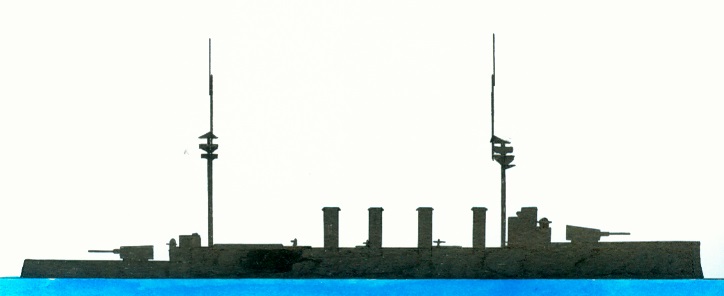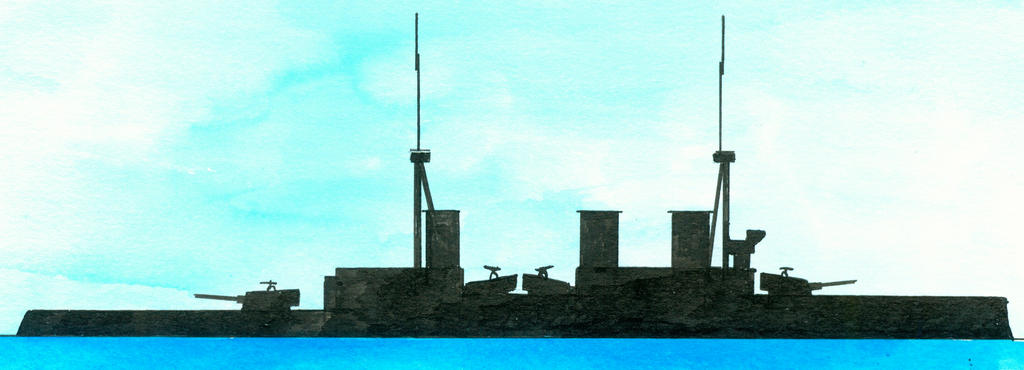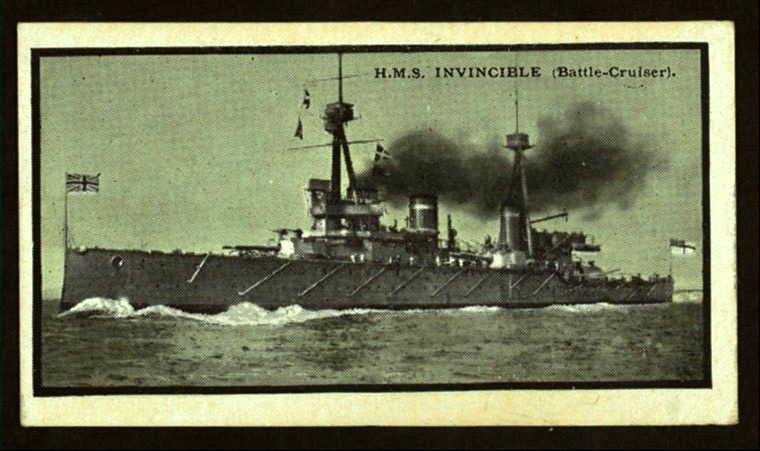Invincible-class predesign A-artist impression
gun arrangement design A
Reciprocating propulsion. Speed 25 knots. Dimensions 540 (between perpendiculars) x 77 x 26.5 (mean) feet and a displacement of 17,000 tons. Main armament 4x2-30.5c,/12”guns.
According to the “instructions to be observed in considering the features which should be incorporated by the director of naval construction in the new designs of ships” was for the armoured cruisers a speed needed of 25 knots, an armament consisting of 12” guns and anti-torpedo craft guns but nothing between. The number of the 12” guns depended on the required speed of 25 knots and reasonable proportions. The armour had to be on similar scale of the Minotaur-class. (1) Further more was carefully attention for the docking facilities asked.
There were several designs drawn. The armoured cruiser in contradistinction to the newly designed battleship (the HMS Dreadnought!) was to be exceptionally strong in end-on gunfire for chasing purposes in stead of broadside gun fire. However the lenth of the engine and boiler rooms combined by the great consequent distance from the centre of gravity where the turrets were mounted resulted into excessive pitching in a seaway making the desired strong end-on gunfire an issue. The alternative to decrease the number of main guns to just 6 was not accepted while the saving in weight with a reduced length was to small and the costs per gun to much increased. After a discussion choose the Committee unanimous for design E. This was an armoured cruiser with a displacement of 16,750 tons and as dimensions 540 x 79 x 26 feet. With a horsepower of 40,000 ihp was het speed to be 25 knots. The armament was to consist of 4x2-12” guns in separate guns mounted on separate redoubts, 20-12pd quick firing anti torpedo boat guns and5 submerged torpedo tubes.
In the meeting of Thursday 12 January 1905 were the effects of blast
discussed and what the most ideal armament was to control this. The designs D
and E were in the meantime prepared. Wooden models with moveable parts were
made and which could be altered to represent the various arrangements of
armament. Designs D and E differs in the disposition of the boradside turrets,
D abreast eacht other and in E en enchelon. Favour of E was that the broadside
turrets were each capable of firing over a certain limited training of the
opposite side of the cruiser. To prevent blast was it impossible to fire on the
same time on the same broadside. However was one gun turret out of action, the
other one still could fire on the opposite side reducing the broadside fire
less than in another disposition. The committee chose for design E but the
director of naval construction (2) was asked to substitute for the foremost
superstructure (design E) a long forecastle extending aft to the after turret
(design E modified). This would improve the seaworthiness and give the
broadside guns more command. On
Wednesday 18 January 1905 was design E unanimously adopted for recommendation
to the Board and to continue with the design proces.
Notes
1. The Minotaur-class was preceded by the Warrior-class, succeeded by the
Invincible-class battle cruisers succeeded by Indefatigable-class. Displacement 14,800 tons and as dimensions
149.4 x 158.2 x 22.7 x 7,9 metres or 490 (between perpendiculars)-519 (over
all) x 74.5 x 26 feet and a main armament of 2x2-23,4cm/9.2” guns. Described by
the British historian R.A. Burt as a cruiser edition of the Lord Nelson-class
battleships which had a displacement of 15,604 (normal)-18,106 (deep load) tons
and as dimensions 443.6 x 79.6 x 30 feet and a main armament of 2x2-30.5 cm/12”
guns. The Invincible-class succeeded by Indefatigable-class, a displacement of
17,530)-20,750 (tons) tons and as dimensions 172.8 (over all) x 23.9 x 9.1
(deep load) metres or 567 x 78.6 x 30 feet, 2 direct steam turbine sets and 31
watertube boilers and a main armament of 4x2-30.5cm/12”. First Sea Lord admiral
Fisher suppported this class until 24 November 1911 called armoured cruisers
and since then battlecruisers.
2. Sir Philip Watts (30 May 1846 Deptford, England-15 March 1926 Chester, London, England), director of naval construction between 1902-1912 and between 1885-1901 director of the war shipping department pf Armstrong Whitworth, Elswick. Since 1912 advisor to the Admiralty on naval construction and director of Armstrong Whitworth.
Sources
The British Library MS 48989. The Jellicoe Papers. Vol 1 (ff. 88). Report
of the Committee on Designs recommending ships such as H.M.S. Dreadnought,
1905. Printed.
Warshipsresearchblogspot.com







No comments:
Post a Comment